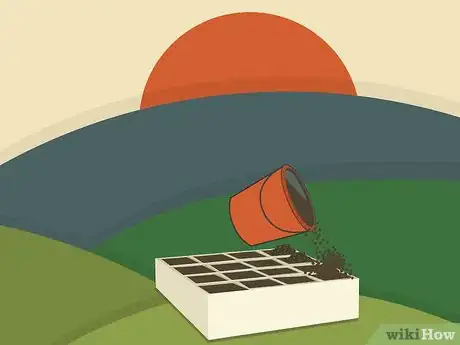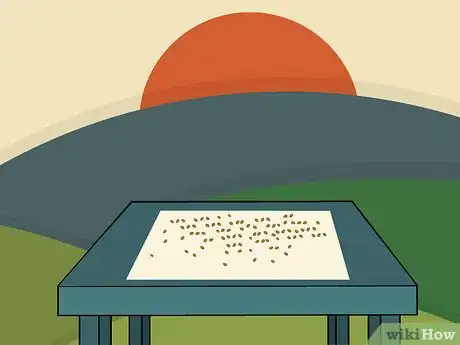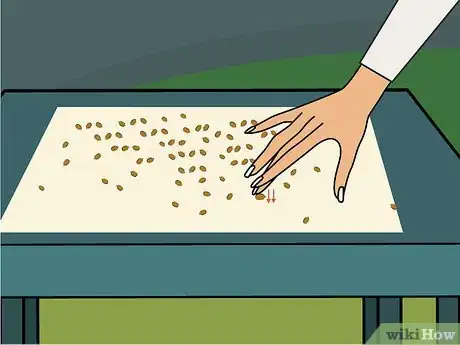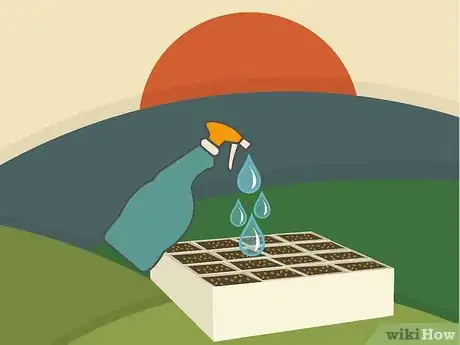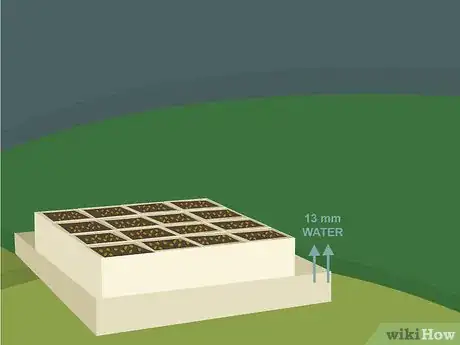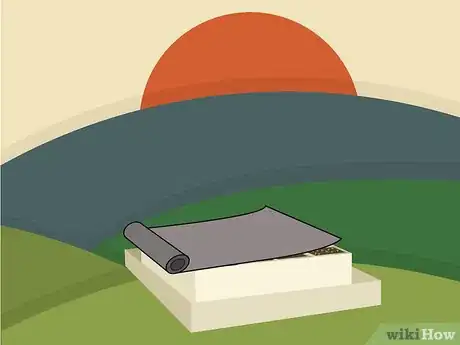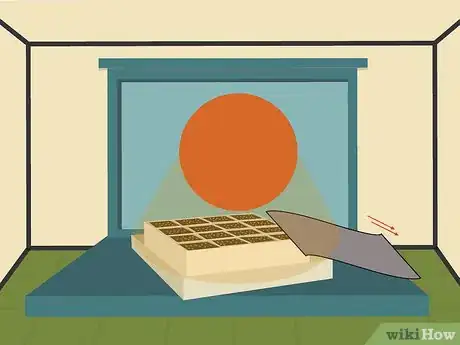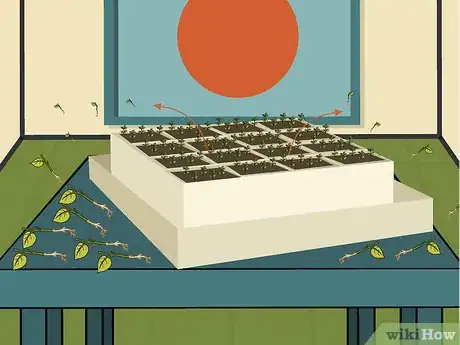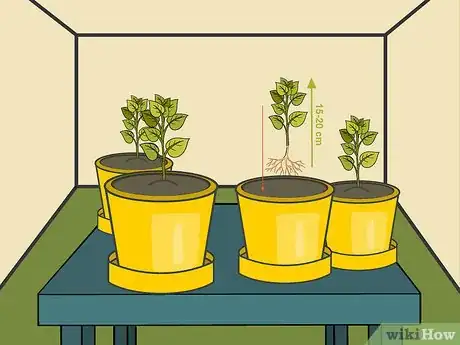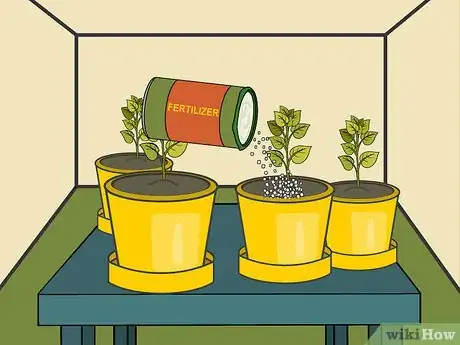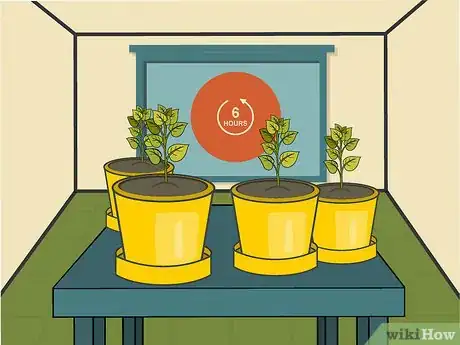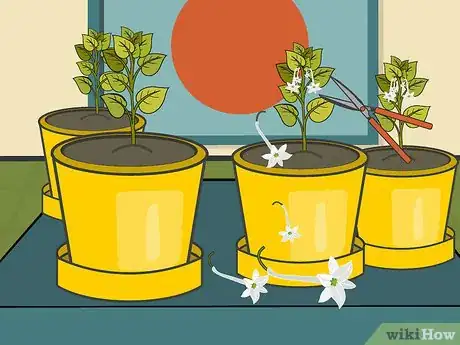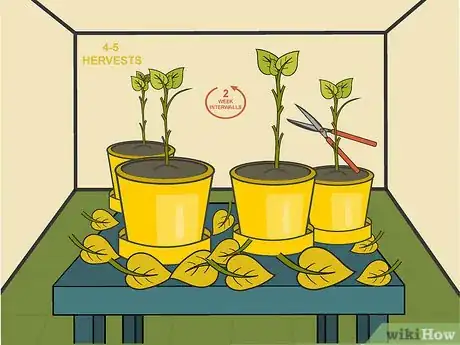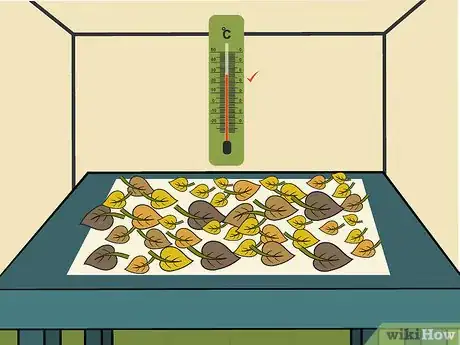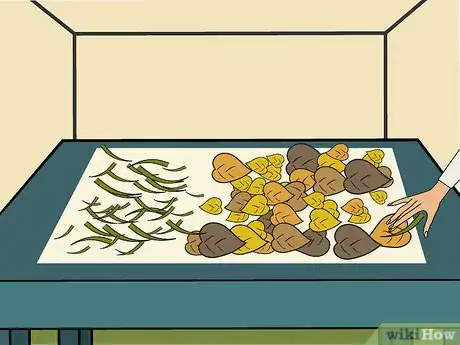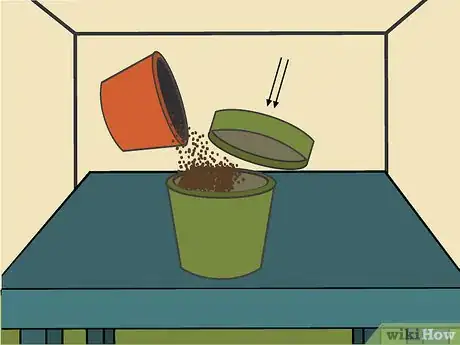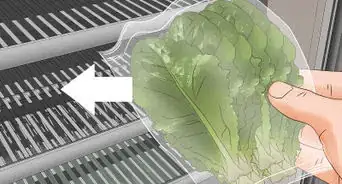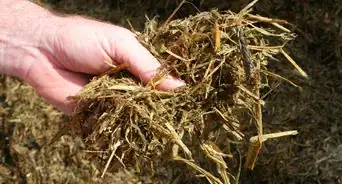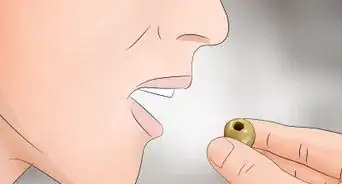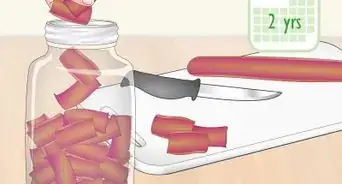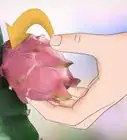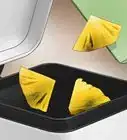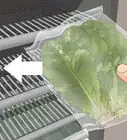This article was co-authored by wikiHow staff writer, Hunter Rising. Hunter Rising is a wikiHow Staff Writer based in Los Angeles. He has more than three years of experience writing for and working with wikiHow. Hunter holds a BFA in Entertainment Design from the University of Wisconsin - Stout and a Minor in English Writing.
There are 19 references cited in this article, which can be found at the bottom of the page.
wikiHow marks an article as reader-approved once it receives enough positive feedback. This article received 13 testimonials and 96% of readers who voted found it helpful, earning it our reader-approved status.
This article has been viewed 297,822 times.
Learn more...
Most of today’s tobacco is grown and processed commercially, but it’s easy to grow tobacco in your own home or garden. While it does take time for it to finish curing, you can have homegrown tobacco that saves you money in the long run.
Steps
Sowing Tobacco Seeds
-
1Fill a cell tray with potting soil. Purchase a cell tray from any gardening store. A tray with drainage holes at the bottom of each cell will work best so the seeds are not waterlogged as they grow. Fill the cells to the top with potting soil that is rich in nutrients.[1]
- If the cell tray does not have holes for drainage, use a knife to cut small slits in the bottom of the cell so water can escape.
-
2Spread the seeds on a white sheet of paper. Tobacco seeds are amongst the tiniest seeds you can purchase and plant. Pour the seeds onto a white piece of paper so you can clearly see how many you have and easily keep control of them.[2]Advertisement
-
3Press the seeds onto the tip of your finger. Rather than trying to plant each seed individually, gently tap a group of seeds. They should easily stick to your finger and you can see how many you are preparing to plant.[3]
-
4Drop 8 to 10 seeds on top of the soil in each cell. Rub your fingers together to drop the seeds into each cell of the tray. Aim for the center of the cell so seedlings do not crowd around the edges. Seedlings growing around the edges could limit root growth for each plant.[4]
- The seedlings may all start to grow, but you’ll be able to thin them out once they start to germinate.
-
5Water the seeds with a spray bottle. Watering will help the seeds embed slightly into the soil. Spray them lightly so the seeds are not pushed around by the force of the water. Wet the topsoil until it is moist, but not so that water is left standing on the surface.[5]
-
6Put the cell tray in a container with 1⁄2 inch (13 mm) of water. The water will come through the drainage holes at the bottom of each cell. Bottom watering helps promote downward root growth as your seeds start to germinate. A cheap plastic tray or container can be used for this.[6]
- Containers that previously held food, like the grocery store packaging for mushrooms, work perfectly for this.
- When the soil feels dry to the touch, refill the container with water.
-
7Cover the seeds with aluminum foil to block the sun. Tobacco seeds will germinate better if they are kept away from any light. Use aluminum foil or any other opaque cover for your seed tray to block the light. Leave room between the soil and the aluminum so air can circulate.[7]
-
8Keep the tray in a warm place for 3 to 4 days. Tobacco seeds usually germinate within the first 3 or 4 days after sowing them. Keep them in a warm area that stays around 75 °F (24 °C), like a windowsill or on top of a water heater. The heat will effectively make a miniature greenhouse for your seeds. Check the seeds each day for sprouts.[8]
-
9Remove the cover and keep it on a windowsill. Once you see small sprouts in each cell, remove the aluminum foil cover and keep the sprouts on a windowsill so they can receive light throughout the day.[9]
Growing Tobacco Plants Indoors
-
1Pluck out half the sprouts from the cell tray with tweezers. After 2 weeks, pick out any seedlings that are growing near the edge of a cell or have grown crooked and sideways. Leave about 5 seedlings in each cell so they will not be overcrowded as they continue to grow.[10]
-
2Transplant seedlings into pots when they are 6 to 8 inches (15 to 20 cm) tall. After the seedlings grow 6 to 8 inches (15 to 20 cm), their roots will be too crowded to stay in the cell tray. Pre-moisten the potting soil in a 2 gallons (7.6 L) pot and make an indentation with your finger equal to the size of one of the cells. Squeeze the bottom of the cell tray to push out the root ball of the tobacco and place it in the indent you’ve made.[11]
- Separate the cells from the tray by cutting them individually with a pair of scissors.
- If the tobacco plant starts to droop or wilts to one side, use a wooden barbecue skewer to support it upright.
-
3Apply a fertilizer with nitrate and no chlorine. Find a fertilizer at your local gardening store that does not contain chlorine and provides nitrogen to your plant in the form of nitrate. Since tobacco is in the same family as tomatoes and peppers, fertilizers manufactured for their use will work just as well. Follow the directions on the package to determine how much fertilizer to use.[12]
- Do not apply any fertilizer after flowers begin to form.
-
4Keep tobacco in an area with 6 hours of sunlight. The more sunlight your plant gets, the larger it will grow. Tobacco plants need full sun throughout the day, so keep them near a large window. If the weather does not drop below freezing, you can also keep them outside during the day and return them inside at night.[13]
- You can also use grow lights to provide enough light for the plant as well as additional warmth.
-
5Water the tobacco so the soil is wet, but not drenched. As tobacco grows, it will require more water. Check the soil daily and keep it moist with a watering can. Don’t allow the water to puddle on the surface. Excessive water will promote diseases like bed rot or mildew to form in the roots.[14]
-
6Cut off flowers as they begin to form. Once a flower forms and blooms, the tobacco will stop growing for the season and reduce your total yield. To keep your plant growing, use a pair of pruning shears to cut off the flowers before they blossom.[15]
Harvesting and Curing Tobacco Leaves
-
1Remove the bottom leaves when they turn slightly yellow. Soon after you remove the flowers from the tobacco plant, the bottom leaves will start to yellow and deteriorate. Use a pair of pruning shears or scissors to remove the lowest leaves on the plant.[16]
-
2Cut the leaves off the stem in 4-5 harvests at 2-week intervals. You don’t want to remove all the leaves from tobacco right away since they will continue to grow and develop. Starting from the bottom, remove leaves as they turn yellow every 2 weeks.[17]
- Alternatively, you can cut the entire stalk down 3-4 weeks after you remove the flowers, but the lower leaves may be partially deteriorated at this time.
-
3Hang the leaves by their stems on a line to dry for 3 weeks. Tie a string to the stems of the tobacco leaves and hang them to dry. Leave space in between the leaves so they can dry out. The leaves should stay soft and move around easily without being crinkled or flaky. As they lose moisture, the leaves will start to turn yellow and brown.[18]
-
4Store the tobacco in a room between 60 to 95 °F (16 to 35 °C) to cure it. Aging and curing tobacco helps the leaves get rid of their herby flavor and makes them taste more desirable. Hang the tobacco where the humidity is consistently around 65 percent. The process can take up to 8 weeks, and the longer you wait, the better it may taste. During this time, the leaves will brown and start to feel leathery to the touch.[19]
- A room where you can control air flow is the best place to hang and cure the tobacco.
- You can age the tobacco for up to 3 years for the flavor to fully develop.
-
5Remove the stems from the leaves by hand. When the leaves aren’t sticky to the touch, you can start removing the main stems from the leaves. The leaves should easily pull away from the stem.[20]
-
6Shred the leaves with a blender. Once the tobacco is dried and cured to your liking, put the leaves in a blender to shred it finely. This will make it easier for you to roll it into a cigarette or smoke in a pipe.[21]
-
7Store shredded tobacco in airtight jars to keep it moist. If tobacco loses its moisture, it will lose some of its flavor. Storing tobacco in an airtight jar will help preserve the flavor for the longest amount of time.[22]
- Add a few drops of vanilla extract or another flavoring to enhance the flavor of your tobacco.
Community Q&A
-
QuestionIf I cut my plant back, will it produce more branches?
 Community AnswerNo. You only need to take out the flowering bud as soon as you see it. If you cut back the plant, it only reduces the size of the leaves.
Community AnswerNo. You only need to take out the flowering bud as soon as you see it. If you cut back the plant, it only reduces the size of the leaves. -
QuestionHow do I make tobacco menthol flavored?
 Community AnswerYou get menthol crystals and dissolve them in water. Then get a spray bottle and spray the saturated water on the tobacco.
Community AnswerYou get menthol crystals and dissolve them in water. Then get a spray bottle and spray the saturated water on the tobacco. -
QuestionIs it illegal to grow tobacco?
 Community AnswerNo, it is not illegal to grow tobacco in the UK or US or the EU. However it is illegal to sell without a license and tax.
Community AnswerNo, it is not illegal to grow tobacco in the UK or US or the EU. However it is illegal to sell without a license and tax.
Warnings
- Check your local laws to determine if growing personal tobacco is legal in your area.⧼thumbs_response⧽
- Growing tobacco for your own personal use is legal, but you cannot legally barter or sell to anyone.[24]⧼thumbs_response⧽
Things You’ll Need
- Cell tray
- Potting soil
- White paper
- Spray bottle
- Container that the cell tray fits into
- Aluminum foil
- 2 gallons (7.6 L) pots
- Fertilizer
- Grow lights
- Pruning shears
- String or wire
- Blender
- Airtight jars
References
- ↑ https://youtu.be/BqOKNg3Zea0?t=1m42s
- ↑ https://youtu.be/BqOKNg3Zea0?t=1m20s
- ↑ https://youtu.be/BqOKNg3Zea0?t=2m45s
- ↑ https://youtu.be/BqOKNg3Zea0?t=2m50s
- ↑ https://youtu.be/BqOKNg3Zea0?t=3m10s
- ↑ https://youtu.be/BqOKNg3Zea0?t=4m15s
- ↑ https://youtu.be/BqOKNg3Zea0?t=4m44s
- ↑ https://youtu.be/BqOKNg3Zea0?t=4m47s
- ↑ https://youtu.be/BqOKNg3Zea0?t=6m49s
- ↑ https://youtu.be/oFxDBALF9Dc?t=56s
- ↑ https://youtu.be/EpZjv_M961U?t=3m11s
- ↑ http://ufdc.ufl.edu/IR00001490/00001
- ↑ http://www.rltt.com.lb/Article/32/factors-affecting-tobacco-growth/en
- ↑ http://ufdc.ufl.edu/IR00001490/00001
- ↑ http://www.howtogrowstuff.com/how-to-grow-tobacco/
- ↑ http://www.howtogrowstuff.com/how-to-grow-tobacco/
- ↑ http://ufdc.ufl.edu/IR00001490/00001
- ↑ https://youtu.be/xKduAMF-lWk?t=47s
- ↑ http://ufdc.ufl.edu/IR00001490/00001
- ↑ https://youtu.be/xKduAMF-lWk?t=1m49s
- ↑ https://www.vice.com/en_au/article/pae75k/we-asked-a-tobacco-farmer-if-growing-your-own-chop-chop-is-worth-it
- ↑ https://pipesmagazine.com/blog/pipe-smoking-lifestyle/pipe-tobacco-storage-2/
- ↑ http://ufdc.ufl.edu/IR00001490/00001
- ↑ https://www.fda.gov/downloads/tobaccoproducts/newsevents/ucm601047.pdf
About This Article
To grow your own tobacco, all you’ll need are tobacco seeds and a cell tray. You’ll need to place 8 to 10 seeds in each cell of the tray and put it in a container with ½ inch of water. Once the seedlings are 6 inches tall, transplant them into pots to give them room to grow. You’ll need to keep them somewhere they’ll get 6 hours of sunlight, keep the soil damp, and apply a chlorine-free fertilizer with nitrate in it. When they start to grow leaves, remove them every 2 weeks. To process your tobacco leaves, hang them to dry for 3 weeks, then remove their stems and shred them with a blender. For more tips, including how to store your homegrown tobacco so it stays fresh, read on!
